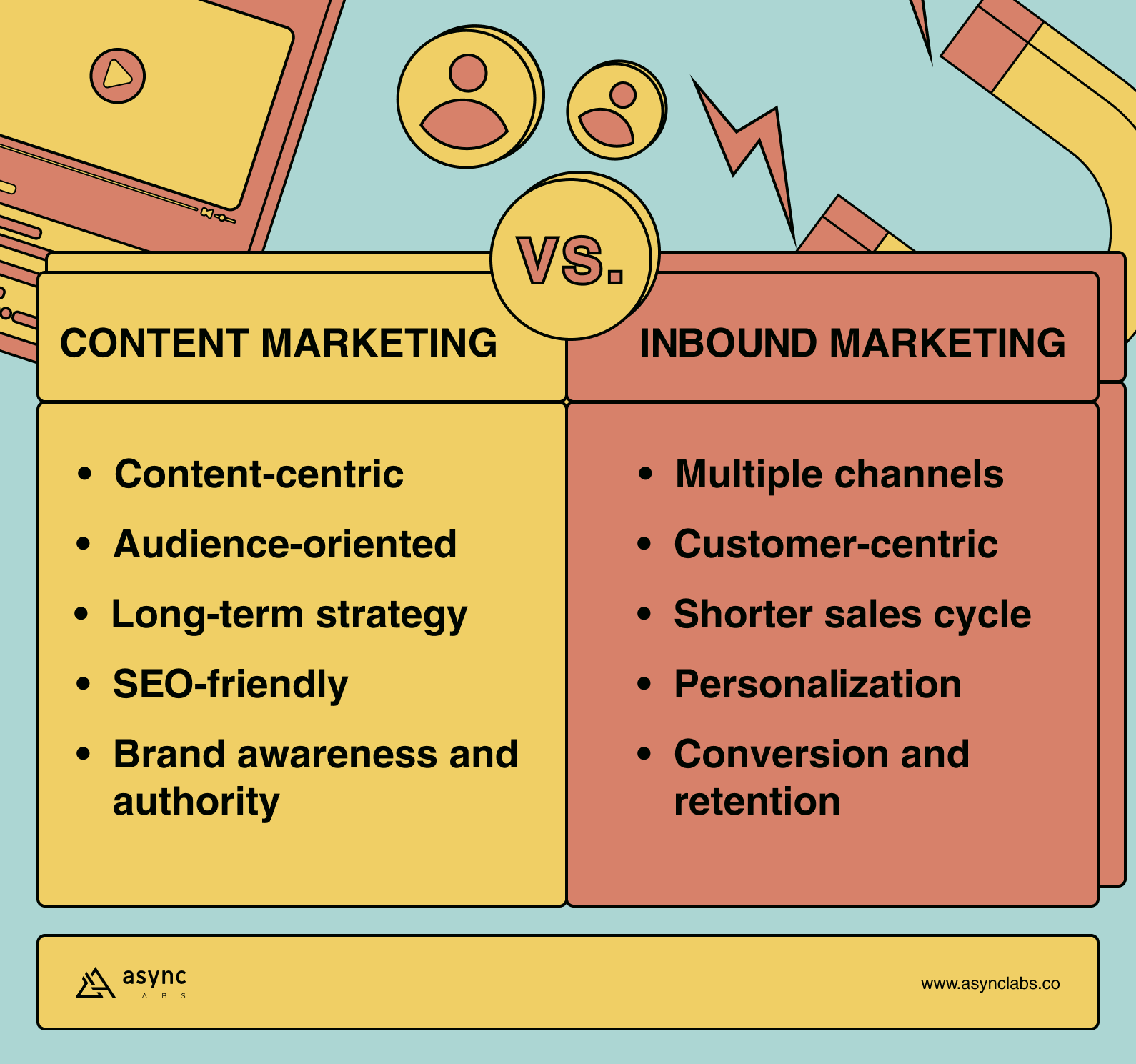Two prominent approaches that often come up in marketing discussions are content marketing vs inbound marketing. And people often need clarification. While they share some similarities and focus on attracting and retaining customers, they are distinct concepts with unique focuses and strategies.
In today’s digital age, marketing has evolved significantly, with businesses adopting various strategies to attract and engage their target audience.
In this blog post, we will dive into the key differences between content marketing vs inbound marketing, SEO impact, why it matters to your marketing strategy, and which approach suits your business best.
What is content marketing and examples
Crafting valuable content
Content marketing is a strategy centered around creating and distributing valuable, relevant, and consistent content to attract and retain a target audience.
- Content marketing can save you up to 62% more and bring three times more leads than traditional marketing.
- An overwhelming 80% of business decision-makers favor obtaining company information through a series of articles over search ads.
The primary goal of content marketing is to establish trust and authority within your niche by delivering high-quality information that addresses your audience’s needs and pain points. This is achieved by educating, inspiring, and engaging customers to drive profitable customer action.
Examples of content marketing include blog posts, social media content, videos, infographics, e-books, and webinars.
Key aspects of content marketing:
- Content-centric: Content marketing revolves around creating various types of content, such as blog posts, articles, videos, infographics, ebooks, and more. This content is designed to educate, entertain, or inform the audience.
- Audience-oriented: Content marketing starts by identifying your target audience and understanding their preferences and interests. The content is then tailored to address the specific needs and challenges of the audience.
- Long-term strategy: Content marketing is a long-term approach that focuses on building relationships and trust over time. It often takes months or even years to see significant results.
- SEO-friendly: Content marketing focuses on search engine optimization (SEO) to ensure that content ranks well in search engine results pages (SERPs), making it discoverable to a broader audience.
- Brand awareness and authority: Through consistent and valuable content, businesses can position themselves as industry leaders and gain authority in their field.

What is inbound marketing
The holistic approach
Inbound marketing is a customer-centric strategy focusing on customer needs and interests. It encompasses various marketing techniques, including content marketing, but extends beyond it. The inbound approach involves creating engaging, helpful, and insightful content that attracts prospects to your website and converts them into customers.
Inbound marketing pulls prospects toward your business by creating content that addresses their pain points and interests rather than pushing your products and services on them. The core idea is to attract, engage, and delight customers at every stage of the buyer’s journey.
Examples of inbound marketing include SEO, social media, email marketing, and lead nurturing.
- Inbound marketing costs $14 less than traditional marketing for each newly acquired customer.
- Inbound leads acquired after five months of consistent inbound marketing are 80% less expensive than outbound leads.
Key aspects of inbound marketing:
- Multiple channels: Inbound marketing leverages a combination of channels, including content marketing, social media, email marketing, SEO, paid advertising, and more, to reach potential customers where they are.
- Customer-centric: Inbound marketing focuses on understanding the buyer’s journey and creating content and experiences that cater to the needs of potential customers at each stage.
- Shorter sales cycle: Inbound marketing aims to efficiently guide prospects through the sales funnel, often resulting in a shorter sales cycle.
- Personalization: Inbound marketing uses data and automation to deliver personalized content and experiences to individual leads and customers.
- Conversion and retention: While content marketing mainly concentrates on attracting and educating, inbound marketing is also concerned with converting leads into customers and retaining them through ongoing engagement.
What is the difference between inbound and content marketing?
Content marketing vs inbound marketing: Key differences
While content and inbound marketing share similarities, the key difference lies in their approaches. Content marketing takes a broad approach that focuses on creating valuable content and distribution across all relevant channels, regardless of whether the audience is a potential customer. Inbound marketing is more targeted in its approach, seeking to attract potential customers who are further along in their decision-making process toward a purchase.
Another way to understand the difference is to think of content marketing as a tool that can be used within inbound marketing. For instance, an inbound marketer may use a blog post (content marketing) to attract and engage potential customers.
A step-by-step guide to content marketing in practice
Content marketing is a powerful tool to help your business drive traffic, generate leads, and boost conversions. But how do you implement a content marketing strategy that works?
Here is how to create a content marketing plan step-by-step:
1. Define your objectives
Before you start your content marketing plan, defining your objectives is crucial. What are your goals? What do you want to achieve with content marketing? Do you want to increase brand awareness, generate new leads, drive traffic to your website, or boost sales? Setting clear objectives is essential because it will guide your content strategy. It will also help you measure the success of your content marketing campaigns.
2. Identify your target audience
Once you have defined your objectives, it’s time to identify your target audience. Who are they? What are their needs, challenges, and pain points? What kind of content are they looking for? Understanding your target audience is crucial because it will help you create relevant, engaging content that resonates with them.
3. Create a content plan
Now that you have your goals and target audience in focus, it’s time to formulate a content strategy. This plan should outline the types of content you want to create, the topics you want to cover, and the channels you will use to distribute your content. Your content plan should also include a content calendar that outlines when you will publish each piece of content.
4. Create engaging content
Now, it’s time to create your content. This is where you get to show your creativity and expertise. Your content should provide value to your target audience. It should be informative, engaging, and relevant. Use different content formats, such as blog posts, videos, infographics, whitepapers, case studies, and social media posts. Remember to optimize your content for search engines by using keywords and meta tags.
5. Distribute your content
Once you’ve created your content, it’s time to distribute it. Use different channels to reach your target audience, such as social media, email marketing, influencer marketing, and paid advertising. Make sure you use the right channels that your target audience uses. Use analytics to measure the success of your content marketing campaigns and make adjustments as necessary.

How to apply inbound marketing in practice
Marketing is all about connecting with your audience, delivering value, and building long-term relationships. In this context, inbound marketing has emerged as a powerful tool businesses can use to attract, engage, and delight customers.
Inbound marketing focuses on creating valuable content that addresses the pain points of your target audience and attracts them to your brand. This approach differs from traditional marketing methods that rely on interruptive advertising, such as TV commercials or billboards, to reach their audience. Inbound marketing is about creating a helpful, informative, and engaging experience that puts your customers in control and encourages them to engage with your brand.
Here is how to apply it to drive growth for your business:
1. Attracting your audience with content
The first step in inbound marketing is attracting your audience with content. This means creating content that addresses your target audience’s needs, challenges, and interests. You can use SEO tactics and social media to promote your content and get it in front of the right people.
For example, you’re a B2B software company that sells project management tools. Your target audience would be project managers, team leads, and executives looking to manage their projects better. To attract this audience, you could create blog posts covering project planning, team collaboration, and time management. By doing so, you’re showcasing your expertise in the field and gaining visibility with your target audience.
2. Engaging your audience with value
Once you have attracted your audience, the next step is to engage them with value. This means delivering content that helps your audience solve their problems, answer their questions, and address their pain points. You can use lead magnets such as ebooks, webinars, or whitepapers to engage your audience further and provide them with even more value.
Using the same example of the B2B software company, you could create an ebook covering remote teams’ best project management practices. This ebook would provide a detailed guide on managing remote teams effectively and be a valuable resource for your target audience.
In addition to lead magnets, you can also engage your audience with interactive content such as quizzes, surveys, or assessments. These forms of content provide a personalized experience for your audience, which can help build trust and credibility with your brand.
3. Converting your audience into customers
The ultimate goal of inbound marketing is to convert your audience into customers. To do this, you must provide your audience with content and offers aligned with their needs and interests. This means creating landing pages and offers that are highly targeted and specific to your audience.
For example, if your B2B software company offers a free trial of your project management tool, you would create a landing page highlighting the benefits of your tool and how it can help solve your target audience’s problems. This landing page would then provide a clear call-to-action, such as “Start your free trial now,” which would encourage your audience to take the next step.
4. Delighting your customers with exceptional service
The last step in inbound marketing is to delight your customers with exceptional service. This means providing your customers with an outstanding experience that exceeds their expectations and creates long-term loyalty.
You must focus on providing value at every touchpoint to delight your customers. This includes creating helpful and informative onboarding content, delivering exceptional customer support, and providing ongoing education and resources that help your customers get the most out of your product or service.
Choose the right approach for your business
Content marketing vs inbound marketing? It depends on your business goals, resources, and target audience. Content marketing is an excellent starting point for establishing your online presence, building authority, and attracting an audience interested in your niche. In contrast, inbound marketing provides a more holistic approach, combining various strategies to create a comprehensive customer journey.
Ideally, many businesses use content and inbound marketing techniques to achieve their marketing objectives. Content marketing provides the foundation of valuable, relevant content, while inbound marketing utilizes multiple channels and personalized strategies to engage and convert leads effectively.
Whether you opt for content marketing, inbound marketing, or a blend of both, the key is understanding your audience’s needs, creating valuable content, and adapting your strategies as you monitor results. By doing so, you’ll be well on your way to establishing a strong online presence and building lasting relationships with your customers.
Ready to implement these strategies or need expert guidance? Contact our marketing team today for personalized assistance, and let us help you achieve your marketing goals.
